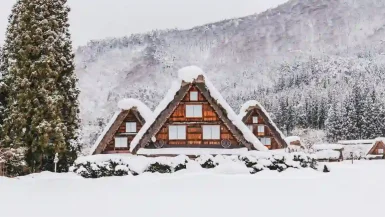Nestled in the heart of Honshu, the Japanese Alps are a stunning mountain range that beckons adventurers and nature enthusiasts alike. These majestic peaks, often compared to the European Alps, offer a blend of breathtaking landscapes, rich history, and cultural treasures. Whether you’re a seasoned hiker, a winter sports enthusiast, or someone seeking tranquility, the Japanese Alps have something to offer. In this comprehensive guide, we’ll explore the allure of this magnificent region, delving into its natural wonders, outdoor activities, cultural experiences, and travel tips.
Introduction to the Japanese Alps
The Japanese Alps, a majestic mountain range, span across central Honshu, the main island of Japan. These mountains are divided into three distinct ranges: the Northern Alps (Hida Mountains), the Central Alps (Kiso Mountains), and the Southern Alps (Akaishi Mountains). Each range boasts unique characteristics, offering visitors diverse experiences and stunning vistas.
The Northern Alps, known for their towering peaks and alpine scenery, are home to some of Japan’s most famous mountains, including Mount Hotaka and Mount Tateyama. The Central Alps, characterized by their rugged terrain and deep valleys, offer a more remote and less-traveled experience. The Southern Alps, with their pristine forests and challenging trails, attract serious hikers and nature lovers.
Natural Wonders of the Japanese Alps
The Japanese Alps are a haven for nature enthusiasts. The region is blessed with a diverse range of flora and fauna, crystal-clear rivers, and serene lakes. During spring and summer, the mountains come alive with vibrant alpine flowers, creating a picturesque landscape that is perfect for hiking and photography.
Mount Hotaka
Mount Hotaka, the highest peak in the Northern Alps, is a must-visit destination for avid hikers. The mountain offers various trails, ranging from moderate to challenging, and rewards climbers with panoramic views of the surrounding peaks and valleys. The Kamikochi Valley, located at the base of Mount Hotaka, is a popular starting point for many hiking adventures. This valley, often referred to as the “Japanese Yosemite,” is prominent for its stunning beauty and serene atmosphere.
Tateyama Kurobe Alpine Route
The Tateyama Kurobe Alpine Route is a spectacular journey through the Northern Alps, offering visitors a chance to experience the region’s natural beauty up close. This scenic route takes you through snow-covered mountains, lush valleys, and crystal-clear lakes. The highlight of the route is the majestic Kurobe Dam, one of Japan’s largest dams, which provides breathtaking views and excellent photo opportunities.
Mount Ontake
Mount Ontake, an active volcano in the Central Alps, is a sacred mountain that has been a pilgrimage site for centuries. The mountain is surrounded by beautiful forests, serene lakes, and hot springs, making it a popular destination for both hikers and spiritual seekers. The Ontake Ropeway provides easy access to the upper slopes, where visitors can enjoy panoramic views of the surrounding landscape.
Outdoor Activities in the Japanese Alps
The Japanese Alps offer a wide range of outdoor activities throughout the year. In the warmer months, you can explore numerous hiking trails that take you through lush forests and past crystal-clear rivers. For the more adventurous, mountaineering challenges await, with peaks like Mount Hotaka and Mount Tate offering stunning panoramic views. During winter, the region transforms into a snowy paradise, perfect for skiing and snowboarding enthusiasts of all levels. Additionally, many resorts in the area provide hot springs (onsen) where you can relax after a day of outdoor adventure, adding a soothing touch to your experience in the Japanese Alps.

Hiking and Mountaineering
Hiking is one of the most popular activities in the Japanese Alps. The region boasts an extensive network of trails, ranging from easy day hikes to multi-day treks. One of the most famous long-distance trails is the Japan Alps Grand Traverse, which spans across the Northern, Central, and Southern Alps. This challenging route takes hikers through some of the most remote and beautiful parts of the Alps, offering stunning views and a true wilderness experience.
For those seeking a less strenuous adventure, the Kamikochi Valley offers several easy trails that provide stunning views of the surrounding peaks and rivers. The Taisho Pond and Myojin Pond are particularly picturesque spots that are easily accessible from the Kamikochi Valley.
Winter Sports
During the winter months, the Japanese Alps transform into a winter wonderland, attracting skiers and snowboarders from around the world. The region is home to several world-class ski resorts, including Hakuba Valley, which hosted events during the 1998 Winter Olympics. Hakuba Valley offers a wide range of slopes for all skill levels, as well as excellent facilities and après-ski activities.
Nozawa Onsen, another popular ski resort, is famous not only for its excellent skiing but also for its traditional hot springs. After a day on the slopes, visitors can relax in one of the many onsens and soak in the rejuvenating mineral waters.
Climbing and Canyoning
For those seeking an adrenaline rush, the Japanese Alps offer excellent opportunities for rock climbing and canyoning. The rugged terrain and numerous waterfalls provide the perfect backdrop for these adventurous activities. In particular, the Omachi area, located in the Northern Alps, is famous for its challenging climbing routes and stunning canyoning experiences. Moreover, these activities are suitable for both beginners and experienced adventurers. Guided tours available to ensure safety and maximize enjoyment. After a day of adventure, you can unwind in one of the area’s many hot springs, offering a relaxing end to your exhilarating experience in the Alps.
Cultural Experiences in the Japanese Alps
The Japanese Alps are not only a paradise for nature lovers but also a region rich in cultural heritage. In addition to its natural beauty, the area is notable for its charming villages, ancient temples, and traditional festivals. These places and events offer a glimpse into Japan’s rich history and culture. For example, the historic village of Shirakawa-go, with its iconic thatched-roof houses, is a UNESCO World Heritage site. It showcases traditional Japanese architecture. Moreover, the region’s temples, such as Zenko-ji in Nagano, are not only religious sites but also historical landmarks that have stood for centuries. During your visit, participating in local festivals, like the Takayama Matsuri, allows you to experience vibrant cultural traditions. These festivals have been passed down through generations, making the Japanese Alps a destination.
Takayama
The historic town of Takayama, located in the Hida region of the Northern Alps, is popular for its well-preserved Edo-period streets and traditional wooden houses. The town is famous for its biannual Takayama Festival, one of Japan’s most beautiful festivals, featuring elaborately decorated floats and traditional music performances. Visitors can also explore the Takayama Jinya, a historic government building, and sample local delicacies at the bustling morning markets. In addition to its cultural attractions, Takayama serves as a gateway to the nearby UNESCO World Heritage site of Shirakawa-go, known for its unique gassho-zukuri farmhouses.
Furthermore, the town’s hot springs and ryokan offer a relaxing retreat after a day of sightseeing. Takayama’s charm lies in its ability to seamlessly blend historical preservation with natural beauty, making it a must-visit destination in Japan. For those interested in traditional crafts, the town also boasts several artisan workshops.Here visitors can observe and purchase handmade goods. Ultimately, Takayama offers a rich and immersive experience that captures the essence of Japan’s rural and cultural heritage.
Matsumoto
Matsumoto, a charming city in the Central Alps, is home to one of Japan’s most beautiful castles, Matsumoto Castle. This “Crow Castle,” with its striking black exterior, is a national treasure and offers stunning views of the surrounding mountains. The city is also famous for its vibrant arts scene, with numerous galleries and museums showcasing traditional and contemporary Japanese art. In addition to the castle, Matsumoto is known for its historical streets. In Nakamachi you can explore well-preserved Edo-period merchant houses. Moreover, the city hosts the annual Matsumoto Performing Arts Festival, attracting artists and performers from across Japan. For those interested in nature, nearby Kamikochi offers breathtaking hiking trails through the Japanese Alps. The trails are making Matsumoto an excellent base for both cultural and outdoor adventures. Finally, don’t miss the local specialty, soba noodles, which are a must-try for any visitor to the region.
Kiso Valley
The Kiso Valley, located in the Central Alps, is famous for its well-preserved post towns along the Nakasendo Trail, an ancient route that connected Tokyo and Kyoto during the Edo period. The towns of Tsumago and Magome are particularly picturesque, with their traditional wooden buildings, cobblestone streets, and scenic surroundings. Walking along the Nakasendo Trail, visitors can experience a journey back in time and enjoy the tranquil beauty of the Japanese countryside.
Travel Tips for Visiting the Japanese Alps
To make the most of your visit to the Japanese Alps, here are some practical travel tips:
Best Time to Visit Japanese Alps
The best time to visit the Japanese Alps depends on your interests. For hiking and outdoor activities, the summer months from June to September offer the most favorable weather. The autumn months of October and November are ideal for enjoying the stunning fall foliage. If you’re interested in winter sports, the ski season typically runs from December to March.
Getting Around
The Japanese Alps are well-connected by public transportation, making it easy to explore the region. The JR (Japan Rail) network provides convenient access to major towns and cities, while local buses and trains connect smaller villages and attractions. Additionally, the extensive rail and bus networks ensure that even remote areas can be reached without difficulty. For those looking to maximize their travel experience, the Japan Rail Pass is a cost-effective option. It’s allowing unlimited travel on JR trains for a set period. Furthermore, this pass covers not only the Shinkansen (bullet trains) but also regional trains, making it ideal for exploring the diverse landscapes of the Japanese Alps. To make your journey even smoother, consider combining train travel with local buses. It take you directly to hiking trails, hot springs, and other natural attractions.
Accommodation
The Japanese Alps offer a wide range of accommodation options to suit all budgets and preferences. For those seeking a more immersive experience, traditional ryokans (Japanese inns) provide a unique cultural stay, complete with tatami mat rooms, futon bedding, and delicious kaiseki meals. If you prefer modern comforts, there are also numerous hotels equipped with all the amenities you need for a comfortable stay. Additionally, budget-conscious travelers can find cozy guesthouses that offer a more affordable yet still authentic experience. For the adventurous, mountain huts provide basic accommodations right on the hiking trails, allowing you to wake up surrounded by the stunning natural beauty of the Alps. Ultimately, whether you’re looking for luxury, tradition, or a simple place to rest after a day of exploring, the Japanese Alps have something to offer every type of traveler.
Packing Essentials
When visiting the Japanese Alps, it’s important to pack appropriately for the season and activities. For hiking and outdoor adventures, be sure to bring sturdy hiking boots, comfortable clothing, and a waterproof jacket. In winter, pack warm clothing, gloves, and a hat to stay comfortable in the cold weather. Additionally, don’t forget to bring sunscreen and sunglasses, as the sun can be intense at higher altitudes. If you plan on staying overnight, a lightweight backpack and essentials like a water bottle, snacks, and a first-aid kit are crucial. Moreover, if you’re visiting during the warmer months, insect repellent can be helpful to ward off any pests while exploring the trails.
Conclusion
The Japanese Alps are a destination that truly has it all. From the towering peaks to the charming mountain villages, this region offers something for every traveler. Whether you’re seeking adventure, relaxation, or a deeper understanding of Japanese culture, the Japanese Alps will not disappoint. Immerse yourself in outdoor activities like hiking, skiing, or hot spring bathing, all set against the backdrop of stunning alpine scenery. As you explore, you’ll discover traditional ryokan inns, ancient temples, and local festivals that showcase the rich cultural heritage of the area. Plan your journey, pack your bags, and get ready to explore the majestic beauty of the Japanese Alps.



